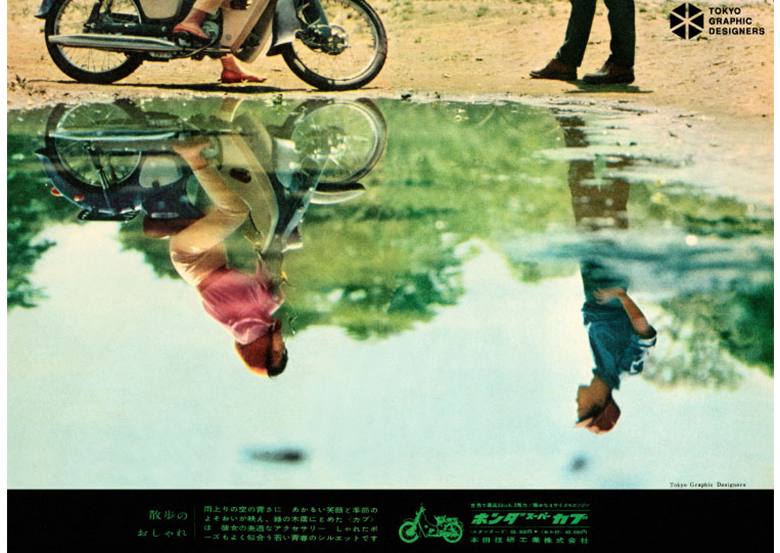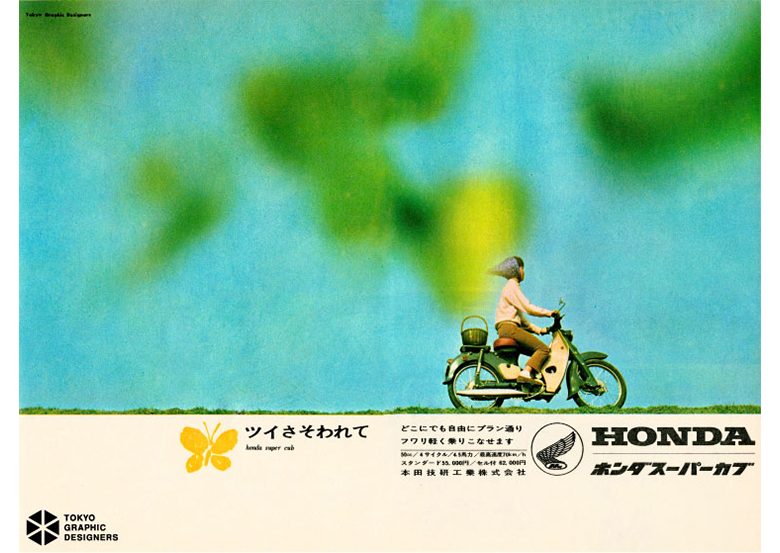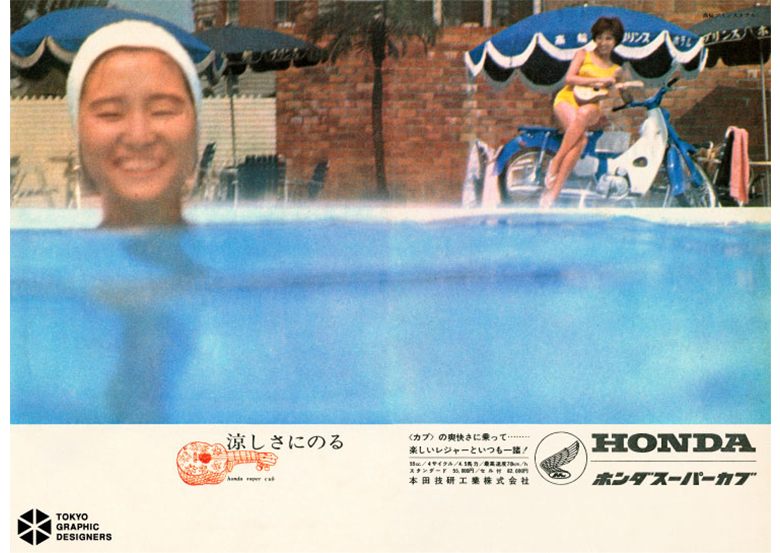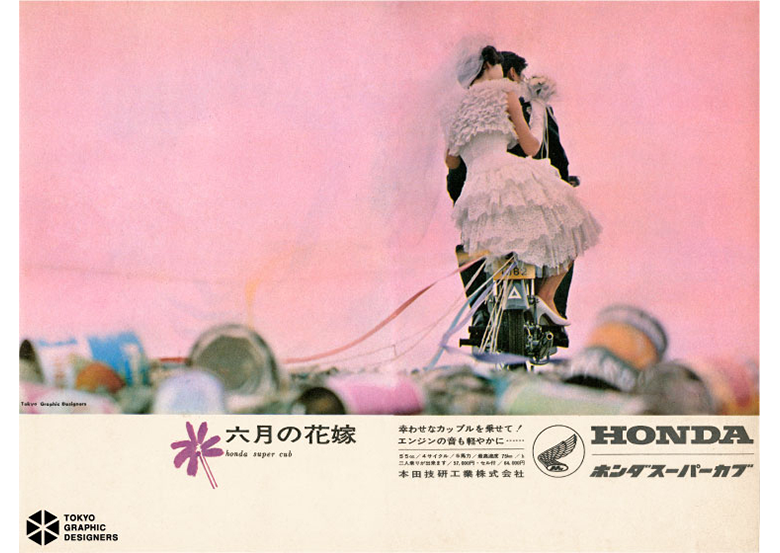Cub Stories
Unprecedented: Super Cub Ads in Women's Magazines
As the Super Cub’s continuous stream of weekly magazine ads began to enjoy a surge of popularity, the time had come develop advertisements for women’s magazines. Ogata described the impact these ads had on people at the time:
“Motorcycle ads were simply not seen in women’s magazines in those days. People in other advertising and publication companies were astounded when we ran them. However, those advertisements are now kept in the collection of a print museum as testament to how revolutionary they were for the time.”
One prominent feature of the Super Cub ads that Fujisawa and Tokyo Graphic Designers developed for women’s magazines was the elegance and beauty of their photography. Ads developed for the weekly magazines were mostly single-page advertisements, often using snapshot-style photos. However, the advertisements used in women’s magazines were all double-page spreads employing modern color photography. The young women who appeared in them were depicted as representatives of a new era enjoying active, independent lifestyles. These ads exhibited a remarkable sense of innovation and could almost be considered pioneers of feminism.
The “Dainamikku-na seishun-no kūkan” (Dynamic Space of Youth) ad featured an aerial photo of a girl riding the Super Cub along a sandy beach washed by white waves. “Chotto kōgen-e” (Short Trip to the Highlands) showed a young woman in the woods, lounging in a hammock reading a book. “Taiyō-ga ippai” (High Noon) depicted a woman enjoying a sand bath on a beach. “Kabu-de chokkō!” (No Detours on a Cub!) depicted a female skier being pulled along by the Super Cub. “Sanpo-no oshare” (A Fashionable Stroll) showed a woman on a Super Cub and the man accompanying her reflected on water. “Tsui, sasowarete” (Invitation to Temptation) showed a woman riding the Super Cub along a springtime river bank, and “Suzushisa-ni noru” (Cool Riding) featured people playing in a swimming pool in summer. These indelible images of life were immortalized in a stream of advertisements created in quick succession.
Most impressive of all was the “Rokugatsu-no hanayome” (June Bride) ad in which a young lady in her wedding dress leans on the shoulder of her man, both seated on the Super Cub’s tandem seat with the pastel shades of a pink-clouded sky in the background. This ad was accompanied by the copy, “Let the happy couple ride! To the soft sounds of an engine…” and indeed the words ‘June Bride’ themselves were in vogue at the time.
Ads Revealing the Super Cub’s Essence Contribute to Pioneering Strengths
Ogata recounted an interesting story behind the development of the women’s magazine ads. “Whenever a woman wanted to buy a Super Cub, she’d have to visit a local Honda dealer. However, the shop would usually smell of dirt and oil, and there would invariably be a grumpy old man running the place. Although he might be a reliable dealer who also provided riding instructions for his mostly male clientele, he rarely knew how to handle the situation when a female customer came through the door. The female customer would also be shocked and possibly frightened by his gruff manner, and soon would run away after a hurried chat.
“Mr. Fujisawa said such situations seemed to take place with disappointing regularity, and he was at a loss as to what to do about it. So, we tried to think of a way to solve this problem. As a result, we made up some pretty aprons printed with hearts, flowers and birds, and distributed them to our dealers throughout the country. The idea being that the wife of the shop owner or dealer could wear the apron and deal more effectively one-on-one with the female customers.”
Looking back at the mass advertising activities carried out in that third year after the Super Cub was released, the incredible prescience and sensitivity to the changing times was clear. Ads placed in the weekly magazines appealingly showed that a Super Cub could enable more efficient use of time in both work and daily life, and expand a person’s range of activities, thus making lives more enjoyable. This also easily corresponds to the ‘work-life balance’ concept that often turns up in today’s language. Additionally, many of the activities of women, which functioned as the core of advertising development in women’s magazines, are now considered genderless or ‘unisex,’ suggesting that the Super Cub was offering a more diverse new form of mobility.
In other words, these advertisements show that over half a century ago the Super Cub represented a form of mobility that could be accepted today and well into the future.
This can be seen clearly in the Super Cub advertising conceived and produced by Takeo Fujisawa and Tsugio Ogata. Although many attribute Honda’s phenomenal growth to the market’s quick acceptance of its mobility products, Honda’s innate ability to more effectively and efficiently convey the essence of its products in advertising was another important factor that tends to be forgotten.
Such large-scale advertising activities turned out to be enormously successful, and the Super Cub sold well throughout the country, eventually coming to play such an integral role in people’s daily lives and work routines that every household seemed to have one. In 1960, the third year after its release, the number of units sold rapidly increased to 564,000, easily exceeding the monthly sales goal of 30,000 units first laid out by Fujisawa. The following year, Honda became the world’s No. 1 maker in terms of a single manufacturer’s motorcycle production volume, and the Super Cub accounted for by far the largest percentage of that volume. By 1966, the eighth year after its release, Honda reached the 5 million units milestone in cumulative sales. The Super Cub had successfully become mobility for the people, as well as a regular fixture seen throughout Japan.
One more legend surrounding the Super Cub ads, involving the famous ‘Nicest People’ sales promotion campaign that was carried out in the United States in 1963, three years after the Super Cub was first released on the American market: Owing to the success of this promotional campaign, the Super Cub soon became an enormous hit in the United States as well. Not so well known is the fact that a series of these advertisements created by Tsugio Ogata was first sent to American Honda as reference materials illustrating the main concept of the campaign—and subsequently went on to become the fundamental idea behind the US campaign. Not only did the Super Cub successfully cross cultural borders, so did its advertising.

The soba shop memorably featured in the Super Cub's very first 'The Soba Is Good, Too, Ma!' magazine ad reappears in the catalog for its 50th anniversary edition

Tokyo Graphic Designers president Tsugio Ogata presents a commemorative plaque to the soba shop owner, who was a little girl at the time that first ad debuted

Soichiro Honda sits astride the Super Cub with a big smile on his face. By 1971, motorcycle production at Honda's Suzuka Plant had surpassed the 10 million units mark.

The famous ‘Nicest People’ campaign that vastly changed the perception of motorcycles in America. What is not so well known is that the origin of this hit campaign was a Super Cub image strategy initially created by the team of Fujisawa and Ogata.







